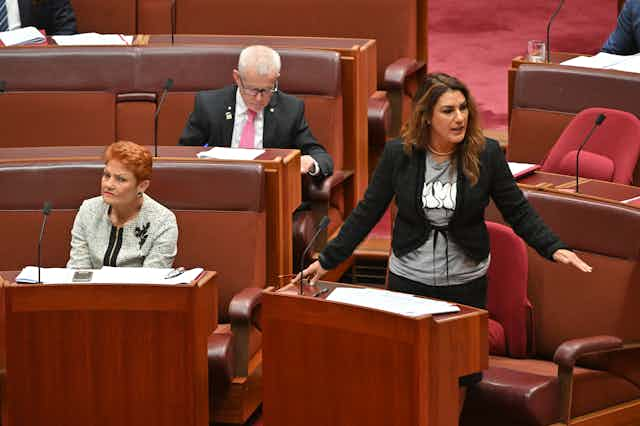On October 14, the voting public will be asked to vote “yes” or “no” on a proposed First Nations Voice to Parliament.
While the “yes” campaign has largely coalesced behind a single message, the “no” campaign is not a singular cohort. There are two sides to the “no” camp and they are very different.
Here’s what they are arguing and the different approaches they’ve taken when it comes to style and tone.
The conservative ‘no’ campaign
One side of the “no” campaign comes from the right of politics, including prominent members of the Coalition. With the catch phrase, “If you don’t know, vote no”, this camp hopes to impel voters who are unsure about what it all means to just vote no instead of finding the information required.
Also in this camp are a number of Australians who believe Indigenous people are beneficiaries of special privileges. Some claim the referendum is about introducing “racial privilege” by establishing a system of government that gives Indigenous people influence over decisions made by the government.
“No” proponents have cited former Prime Minster Bob Hawke to make their case that we should all just be considered Australian and Indigenous people should not have a moral or legal right of recognition or special land rights. Hawke said in 1988:
In Australia, there is no hierarchy of descent […] there must be no privilege of origin. The commitment is all. The commitment to Australia is the one thing needful to be a true Australian.
One of the drivers behind this “no” campaign is Fair Australia, an arm of the lobbying group Advance Australia. Advance counts former Prime Minister Tony Abbott as an advisory member and is backed by wealthy donors.
These groups are harnessing social media to push their arguments, which mainly revolve around two themes: “dividing” the nation, and the lack of detail masking a hidden agenda.
This side of the “no” camp has faced many accusations of spreading misinformation.
Senior Indigenous politician Senator Jacinta Nampijinpa Price is the Liberal party’s spokesperson against the Voice and the main Indigenous voice in the conservative “no” camp. Liberal Party leader Peter Dutton recently appointed Price as the new shadow minister for Indigenous Australians.
The Blak Sovereign ‘no’ campaign
The other side of the “no” campaign is completely different in that it professes to have the best interests of Aboriginal and Torres Strait Islander people at its core.
This camp is often framed as the progressive side of the “no” campaign, with independent Senator Lidia Thorpe its most prominent voice. Thorpe has referred to the Voice as a “powerless advisory body” that will do little to change the life circumstances of most Aboriginal and Torres Strait Islander people. Instead, Thorpe supports other measures such as truth-telling and treaty.
Thorpe has said the Voice is just an easy way to fake any real progress for Indigenous people without any actual change.
She also points to the harm and divisiveness the Voice debate has caused, referring to it as a “destructive distraction”. The Voice debates have resulted in a significant rise of racism and hate speech targeting Indigenous people online.
While both sides are supporting a “no” vote, they are distinct in that one’s aim is for Aboriginal and Torres Strait Islander people to have more rights of self-determination, while one advocates for the status quo.
Where does this leave Indigenous people?
Voice proponents believe it will bring the promise of a new and enlightened Australia. But in reality, the government will be able to disregard the advice it brings to the parliament.
Arrernte writer Celeste Liddle captures how many Aboriginal and Torres Strait Islander people are feeling about the referendum:
I feel stuck with a choice between systems I do not trust and the fear of giving in to rabid racists.
Aboriginal and Torres Strait Islander people are tired of dealing with the misinformation, lies, hatred and racism the referendum debate is fuelling in society. I was asked by a non-Indigenous person if it is true Aboriginal people will get double Centrelink payments and be “given” land for free.
These falsehoods are repeatedly being spread because they hit at the heart of the racism we see in Australia – that Aboriginal and Torres Strait Islander people will be entitled to something other Australians are not, and we are undeserving.
Many have questioned Australia’s ability to engage in a debate over the Voice without descending into racist stereotypes and contempt for Indigenous people.
My own research has pointed to high levels of ongoing racism online and in workplaces.
Australians need to be fully informed and not swayed by misinformation fuelled by racism. We are told there is much at stake, but we do not yet know if the Voice will bring any substantial change for Aboriginal and Torres Strait Islander people. This campaign will, however, tell us who we are as a people, and what we value.

